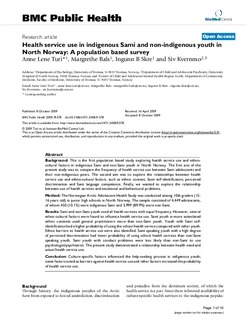| dc.contributor.author | Turi, Anne Lene | |
| dc.contributor.author | Bals, Margrethe | |
| dc.contributor.author | Skre, Ingunn B. | |
| dc.contributor.author | Kvernmo, Siv | |
| dc.date.accessioned | 2017-06-07T12:37:01Z | |
| dc.date.available | 2017-06-07T12:37:01Z | |
| dc.date.issued | 2009 | |
| dc.identifier.citation | Turi, A.L., Bals, M., Skre, I.B. & Kvernmo, S. (2009) Health service use in indigenous Sami and non-indigenous youth in North Norway: a population based survey. BMC Public Health, 9(October), s. 378-387. | |
| dc.identifier.uri | http://hdl.handle.net/11250/2444931 | |
| dc.description | Artikkel som omhandler bruk av helsetjenester blant samisk og ikke-samisk ungdom i Nord-Norge. | |
| dc.description.abstract | Background: this is the first population based study exploring health service use and ethnocultural factors in indigenous Sami and non-Sami youth in North Norway. The first aim of the present study was to compare the frequency of health service use between Sami adolescents and their non-indigenous peers. The second aim was to explore the relationships between health service use and ethno-cultural factors, such as ethnic context, Sami self-identification, perceived discrimination and Sami language competence. Finally, we wanted to explore the relationship between use of health services and emotional and behavioural problems. Method: the Norwegian Arctic Adolescent Health Study was conducted among 10th graders (15-16 years old) in junior high schools in North Norway. The sample consisted of 4,449 adolescents, of whom 450 (10.1%) were indigenous Sami and 3,999 (89.9%) were non-Sami. Results: Sami and non-Sami youth used all health services with equal frequency. However, several ethno-cultural factors were found to influence health service use. Sami youth in more assimilated ethnic contexts used general practitioners more than non-Sami youth. Youth with Sami selfidentification had a higher probability of using the school health service compared with other youth. Ethnic barriers to health service use were also identified. Sami speaking youth with a high degree of perceived discrimination had lower probability of using school health services than non-Sami speaking youth. Sami youth with conduct problems were less likely than non-Sami to use psychologist/psychiatrist. The present study demonstrated a relationship between health need and actual health service use. Conclusion: culture-specific factors influenced the help-seeking process in indigenous youth; some factors acted as barriers against health service use and other factors increased the probability of health service use. | |
| dc.description.sponsorship | Center for Sami Health Research, UiT; The Norwegian Institute of Public Health | |
| dc.language.iso | eng | |
| dc.rights | Navngivelse 4.0 Internasjonal | |
| dc.rights.uri | http://creativecommons.org/licenses/by/4.0/deed.no | |
| dc.subject | sami | |
| dc.subject | indigenous | |
| dc.subject | youth | |
| dc.subject | health service use | |
| dc.subject | samer | |
| dc.subject | urfolk | |
| dc.subject | ungdom | |
| dc.subject | helsetjeneste | |
| dc.subject | bruk | |
| dc.title | Health service use in indigenous Sami and non-indigenous youth in North Norway: a population based survey | |
| dc.type | Journal article | |
| dc.type | Peer reviewed | |
| dc.rights.holder | Turi, Anne Lene | |
| dc.source.volume | 9 | |
| dc.source.journal | BMC Public Health | |
| dc.source.issue | October | |
| dc.identifier.doi | 10.1186/1471-2458-9-378 | |

